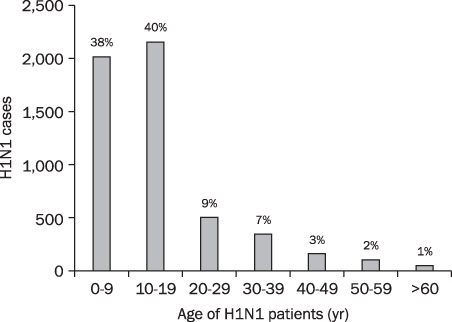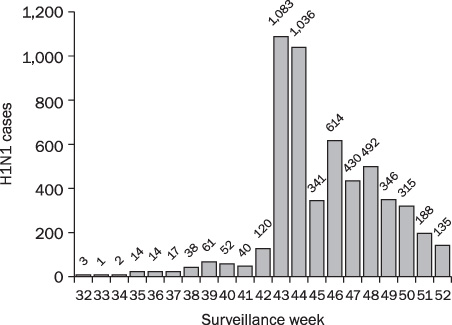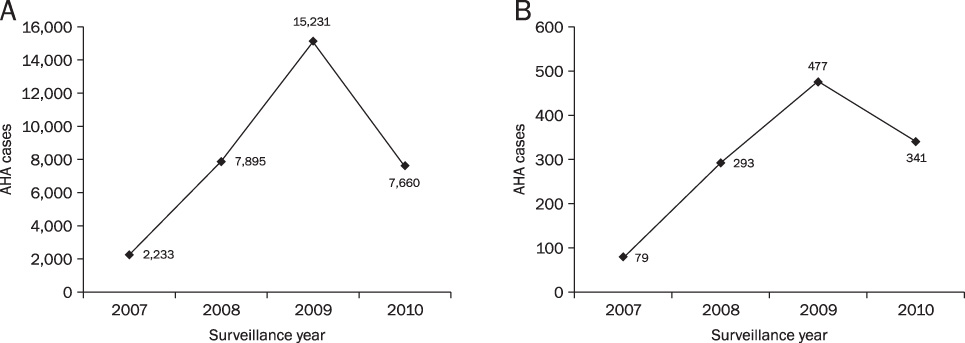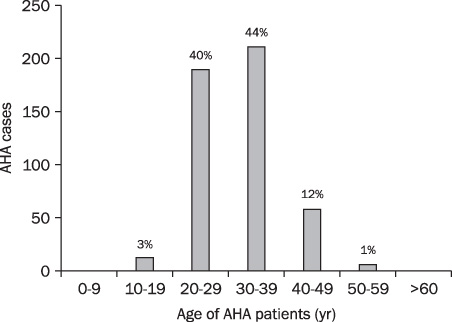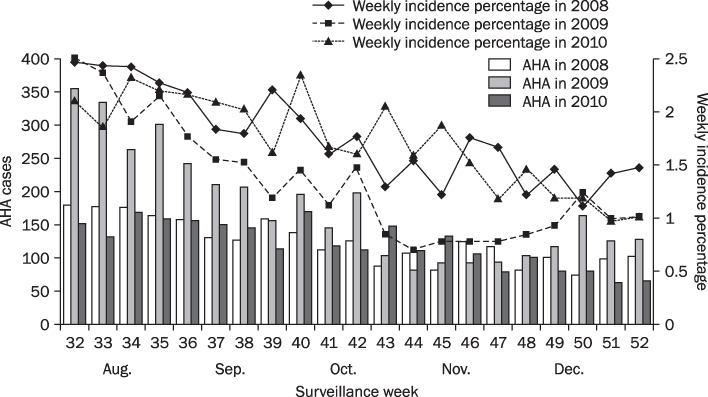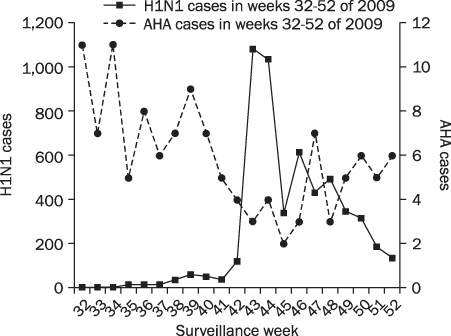Korean J Gastroenterol.
2012 May;59(5):360-365. 10.4166/kjg.2012.59.5.360.
Influenza A (H1N1) 2009 Pandemic Calm Down the Prevalence of Acute Hepatitis A in the Latter Half of 2009: Korean Population Study
- Affiliations
-
- 1Department of Internal Medicine, Soon Chun Hyang University Bucheon Hospital, Soon Chun Hyang University School of Medicine, Bucheon, Korea. mcnulty@schmc.ac.kr
- 2Department of Internal Medicine, Peking University People's Hospital, Beijing, China.
- 3Department of Internal Medicine, Soon Chun Hyang University Seoul Hospital, Soon Chun Hyang University School of Medicine, Seoul, Korea.
- 4Department of Internal Medicine, Soon Chun Hyang University Cheonan Hospital, Soon Chun Hyang University School of Medicine, Cheonan, Korea.
- KMID: 1792835
- DOI: http://doi.org/10.4166/kjg.2012.59.5.360
Abstract
- BACKGROUND/AIMS
There was a spiking incidence of acute hepatitis A (AHA) in 2009 summer, but it went down drastically after an outbreak of influenza A (H1N1). We assessed the relationship between 2009 H1N1 pandemic and AHA prevalence from August to December 2009.
METHODS
We compared AHA cases nationwide and in our hospital for the period from the latter half of 2008 to the end of 2010. H1N1 cases in our hospital from August 2009 to December 2009 were included in the study and the correlation between 2009 H1N1 pandemic and AHA prevalence was assessed.
RESULTS
The national surveillance system reported 2,233, 7,895, 15,231 and 7,660 AHA cases from 2007 to 2010, respectively. A similar trend was noted in our hospital in the same periods. Although the national total incidence was increased in 2009, it showed steep decreasing trend line in the final 21 weeks of 2009 (weeks 32-52), as compared with 2008 and 2010. The mean weekly incidence percentage (AHA cases in a week/total in a year) in weeks 32-52 of 2009 was 1.17+/-0.55%, significantly lower than that in 2008 and 2010 (1.61+/-0.43% and 1.56+/-0.51%; p<0.001). Furthermore, we found a significant negative correlation between 2009 H1N1 pandemic and AHA in our hospital for weeks 32-52 of 2009 (r=-0.597; p<0.001).
CONCLUSIONS
The widespread occurrence of 2009 H1N1 pandemic highlighted the benefits of health care and good hygiene, such as effective hand washing and wearing of masks, which may have also interrupted hepatitis A virus transmission.
MeSH Terms
Figure
Reference
-
1. 2009 H1N1 Flu ("Swine Flu") and You [Internet]. 2010. 02. 10. cited 2011 Jan 30. Atlanta: Centers for Disease Control and Prevention (CDC);Available from: http://www.cdc.gov/h1n1flu/qa.htm.2. What is the pandemic (H1N1) 2009 virus? [Internet]. 2010. 02. 24. cited 2011 Jan 30. Genova: World Health Organization (WHO);Available from: http://www.who.int/csr/disease/swineflu/frequently_asked_questions/about_disease/en/index.html.3. Influenza A (H1N1) - update 9 [Internet]. 2009. 05. 02. cited 2011 Jan 30. Genova: World Health Organization (WHO;Available from: http://www.who.int/csr/don/2009_05_02/en/index.html.4. Feinstone SM, Kapikian AZ, Purceli RH. Hepatitis A: detection by immune electron microscopy of a viruslike antigen associated with acute illness. Science. 1973. 182:1026–1028.5. Sohn YM, Rho HO, Park MS, et al. The changing epidemiology of hepatitis A in children and the consideration of active immunization in Korea. Yonsei Med J. 2000. 41:34–39.6. Jeong SH. Current status and vaccine indication for hepatitis. A virus infection in Korea. Korean J Gastroenterol. 2008. 51:331–337.7. Martin A, Lemon SM. Hepatitis A virus: from discovery to vaccines. Hepatology. 2006. 43:2 Suppl 1. S164–S172.8. Hepatitis A [Internet]. 2008. 05. cited 2011 Jan 30. Genova: World Health Organization (WHO);Available from: http://www.who.int/mediacentre/factsheets/fs328/en/index.html.9. Korea Centers for Disease Control and Prevention. Changing patterns of hepatitis A virus infection in Korea. Public Health Wkly Rep. 2008. 1:169–172.10. Kiely PM, Lian KY, Napper G, Lakkis C. Influenza A (H1N1) and infection control guidelines for optometrists. Clin Exp Optom. 2009. 92:490–494.11. Bell BP. Hepatitis A vaccine. Semin Pediatr Infect Dis. 2002. 13:165–173.12. Innis BL, Snitbhan R, Kunasol P, et al. Protection against hepatitis A by an inactivated vaccine. JAMA. 1994. 271:1328–1334.13. Hammitt LL, Bulkow L, Hennessy TW, et al. Persistence of antibody to hepatitis A virus 10 years after vaccination among children and adults. J Infect Dis. 2008. 198:1776–1782.14. Dagan R, Leventhal A, Anis E, Slater P, Ashur Y, Shouval D. Incidence of hepatitis A in Israel following universal immunization of toddlers. JAMA. 2005. 294:202–210.15. Belmaker I, Dukhan L, Yosef Y, Leventhal A, Dagan R. Elimination of hepatitis a infection outbreaks in day care and school settings in southern Israel after introduction of the national universal toddler hepatitis a immunization program. Pediatr Infect Dis J. 2007. 26:36–40.16. Tong MJ, el-Farra NS, Grew MI. Clinical manifestations of hepatitis A: recent experience in a community teaching hospital. J Infect Dis. 1995. 171:Suppl 1. S15–S18.
- Full Text Links
- Actions
-
Cited
- CITED
-
- Close
- Share
- Similar articles
-
- The 2009 H1N1 Pandemic Influenza in Korea
- A Case of Pandemic 2009 H1N1 Influenza A Manifestation as Apical Ballooning Syndrome
- Epidemiology, clinical manifestations, and management of pandemic novel Influenza A (H1N1)
- Clinical and Laboratory Characteristics of Pandemic Influenza A/H1N1 2009 Infection among Patients with Malignancy in Korea
- Influenza Associated Pneumonia

